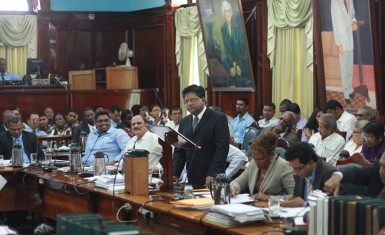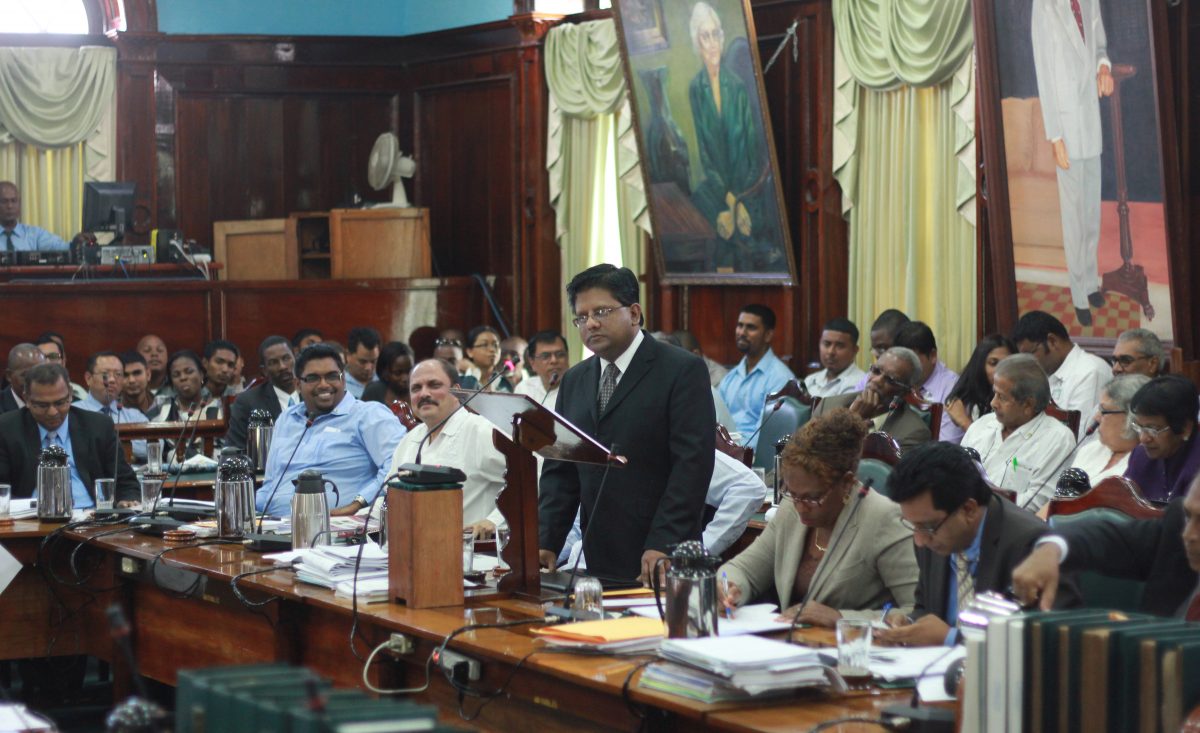Minister of Finance Dr Ashni Singh has unveiled a $208,8 billion national budget blueprint, including plans to trim personal and property taxes, prop up the troubled National Insurance Scheme (NIS) and inject funds into both the ailing Guyana Power and Light (GPL) and the Guyana Sugar Corporation (GuySuCo).
 Singh presented the plan yesterday during an address that lasted little over three hours in the National Assembly, and in which he sought to make a case to build on the gains of what was the seventh consecutive year of real economic growth in the economy.
Singh presented the plan yesterday during an address that lasted little over three hours in the National Assembly, and in which he sought to make a case to build on the gains of what was the seventh consecutive year of real economic growth in the economy.
The plan, presented under the theme ‘Overcoming Challenges Together, Accelerating Gains for Guyana’, is the second budget of the Tenth Parliament and is $16 billion more than what was presented by the Donald Ramotar administration last year before the opposition instituted cuts. Singh and the administration subsequently got a court decision in their favour to restore part of the sum and which they used as justification for release of the remainder, albeit without parliamentary approval.
Before he detailed his proposals, the minister acknowledged the struggle in the legislature between the government and the combined with its one-seat majority, but was hopeful that good sense would prevail going forward, despite a collapse in talks.
In what could be seen as a conservative concession to longstanding calls from both the opposition and the private sector, Singh announced some changes in the taxation regime, including a reduction in the personal income tax from 33.3% to 30%.
The move comes a year after he had announced an increase in the income tax threshold to $50,000, which has been maintained. APNU’s proposals had called for tax reforms, including a lowered VAT, while the Private Sector Commission (PSC) in its formal proposals to government specifically urged a cut in the personal income tax to 28%, saying that the introduction of VAT placed a greater burden on middle-income earners.
“As a result of this reduction in the personal income tax rate, more than 184,000 taxpayers will benefit with higher take home pay, and an additional $1.8 billion of disposable income will be placed annually in the hands of the taxpaying public,” Singh said.
Other taxation changes can also be viewed as concessions to the private sector, which had also proposed abolishing property tax for individuals and a phased reduction of the corporate tax to drive local and foreign investment.
Singh said that first-time homeowners who are holders of mortgage loans from a commercial bank or the New Building Society of up to $30 million will be permitted to deduct the interest they pay on such mortgages from their taxable income for the purposes of personal income tax. “In other words, that portion of taxable income used by a first-time homeowner to pay interest on a housing loan of up to $30 million from a commercial bank or building society will be exempt from personal income tax,” he explained, while noting that the initiative will cost government approximately $580 million but will benefit tens of thousands of first-time low and middle income homeowners.
He also announced a reduction on the property tax on companies, explaining that with effect from next year, the first $10 million of net property will be taxed at zero per cent, the next $15 million of net property will be taxed at 0.5 per cent, and the remainder of net property will be taxed at 0.75 per cent. He noted that currently the first $1.5 million of net property is taxed at zero per cent, the next $5 million of net property is taxed at 0.5 per cent, and the remainder of net property is taxed at 0.75 per cent. In addition, he said the valuation date for the purposes of the property tax will be revised from January 1, 1991 to January 1, 2011.
Also from next year, he said, there would be a reduction of the property tax on individuals, with the first $40 million of net property being taxed at zero per cent, and the remainder of net property being taxed at 0.75 per cent. As with companies, the valuation date for the purposes of the property tax will be revised from January 1, 1991 to January 1, 2011.
Singh, however, made no announcement of an adjustment to the rate of the 16 per cent VAT or the work of the tax reform committee that was set up by the president more than a year ago but which has still not produced any results.
Old age pensions, NIS
A year after he had announced a proposal for a $600 increase for old age pensioners, Singh said the government’s plan for 2013 is to increase the old age pension to $12,500 per month with effect from May 1, 2013. This represents an increase of 25 per cent over the $10,000 that was eventually agreed upon last year after negotiations with the opposition. He said that the annual impact of this increase would result in an additional $1.3 billion of disposable income being placed in the hands of 42,500 senior citizens.
Further, he announced a measure to subsidise the electricity costs borne by old age pensioners and said that this will be done to the tune of up to $20,000 per annum. “This assistance will reduce the electricity charges that will have to be met by each pensioner who is a GPL customer, and will have the effect of increasing the disposable income of our senior citizen population by a further $590 million per annum,” he said.
A similar scheme exists under which government spends over $200 million annually assisting senior citizens in payments to the Guyana Water Incorporated (GWI).
Singh also announced that the contribution rate for both employed and self-employed contributors to the teetering NIS will be increased by 1 percentage point with effect from June 1, 2013.
This measure is expected to generate additional revenue of approximately $890 million per year for the NIS, which was diagnosed last year as nearing a crisis stage last year, after recording its first ever deficit in its 42-year-old history. A deficit was also projected for last year and the most recent actuarial report had proposed urgent reforms, including raising the contribution rate by 2 per cent no later than January this year as well as a phased increase of the pension age from 60 to 65.
With the announcement of the planned 1 per cent increase yesterday, Singh also said government would meet both the employer’s and the employee’s share of the increase in contribution payable with respect to employed persons below the $50,000 tax threshold to ensure “no impact” on the vulnerable.
He noted that although administrative measures might help to improve the financial position of the NIS, these could not possibly totally remedy structural deficiency. “The reality has been growing benefits, a beneficiary population that is aging and therefore in receipt of pensions and other benefits for more years than were anticipated at the time they commenced participation in the scheme, and a contributing population that has not been growing as rapidly as it should especially amongst the self employed,” he said. “The reality is equally that it would be difficult to devise a lasting solution to the challenges faced by the scheme without confronting the need for an increase in the contribution rate,” he said.
Subsidies
All told, the government is seeking to put a total of $11.6 billion into the GPL not only to offset increases in fuel against the backdrop of no new tariff increases but also to allow the company to support capital investment in key projects. While $5.8 billion is for fuel subsidies, a similar sum of $5.8 billion will go towards capital investment projects, the minister announced.
Singh said GPL last raised electricity tariffs in 2007 when fuel prices were lower than they are at present. “The escalation in fuel costs has been borne by GPL in the absence of tariff increases, placing tremendous pressure on the cash flows of the company,” he said, while noting that it was for this reason that government last year injected $6 billion into GPL. The circumstances of the company remain “substantially unchanged,” he added.
Singh also said it is proposed that a sum of $2.9 billion be budgeted as electricity subsidies for Linden and Kwakwani. He said that further consideration of the amount of subsidies will be dependent on the completion of the work of the technical review committee established under the Region Ten/Government of Guyana agreement, following the Linden protests last year, which were triggered by the plan to phase out the subsidies. “At current rates, this translates to a benefit of $279,801 per electricity customer per annum or $23,317 per month. We continue to urge timely completion of the committee’s deliberations so that this matter can be brought to conclusion,” he said.
The government also proposes injecting $1 billion to help GuySuCo meet the financing requirements of its transformation plans. Last year, government provided an injection of $4 billion to the company for the same purpose.
Although he announced government’s muted projections for the sugar industry for this year in the amount of 240,000 tonnes—lower than the industry’s projection—he said the sugar sector is still “of sufficient systemic importance to the national economy and to the livelihoods of so many rural communities.” He added that it has deep forward and backward linkages with suppliers and distributors nationwide that no effort must be spared to ensure its long term viability, competitiveness, and profitability. Over the years, he revealed, the government has injected a total of $39.5 billion to recapitalise the industry and to support its operations.
Singh said his plan “includes something for all Guyanese” and reminded MPs that during its consideration, which will begin next Tuesday, that they should reflect on whether their decisions would bring betterment to the country and its people. “…Our answer must always be motivated, not by the perverse urge to demonstrate the sheer might of the vote we are already known to have, but by the much humbler obligation we owe to use that vote responsibly,” he said, in a statement clearly directed at the opposition benches.

